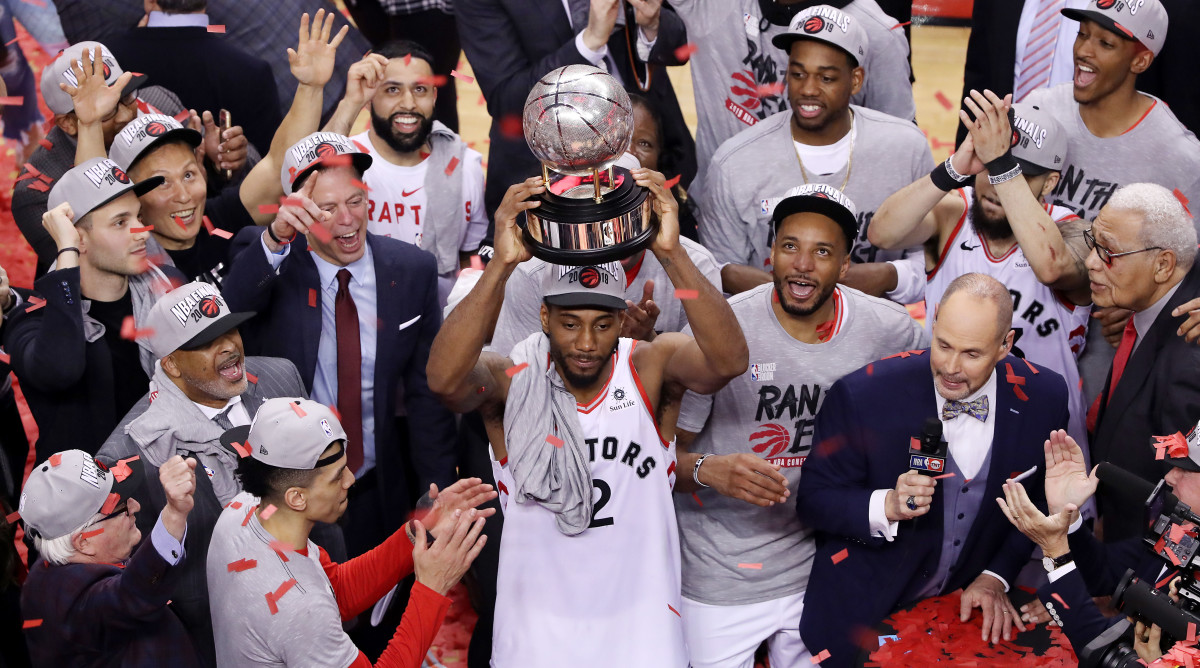How the Warriors Defend Kawhi Leonard Will Decide the NBA Finals

In advance of a championship series that features Stephen Curry, the possible return of Kevin Durant, and the three-peat bid of a dynastic superteam that just swept its way through the conference finals, there is somehow no bigger question than this: What the hell are the Warriors to do with Kawhi Leonard? Three playoff teams before them—and three of the better-coached defenses in the league, no less—tried and failed, finding little that could slow a wing with Leonard’s skill and presence. Accomplished wing defenders were worked over. Traps were sprung and exploited. Something about Kawhi’s game has always seemed immutable, but in these playoffs it has endured heat and pressure and countless blows only to make it to the NBA Finals in perfect form.
A star whose basketball future seemed so oddly uncertain a year ago has renewed his claim as one of the best players in the world. Leonard is the Warriors’ problem now, and the title may well be decided on the grounds of whether the defending champions are up to the task. They tend to be game for these moments; for a team loaded with All-NBA talent, Golden State has always minded the margins for any possible advantage. The goal with a player like Leonard is containment: a defense can’t stop a player capable of scoring at every level, but limiting the possible outcomes can at least make him grind against the odds. It’s easy for Leonard to make way for his mid-range game when his defender must also fear the drive, knowing full well that one false step could usher him all the way to the rim. Some creators, by speed or style, leave room for a defender to recover. Leonard isn’t so forgiving. Once he brushes an opponent aside, their relevance to a possession is effectively over.

You won’t rush him, or surprise him, or hustle your way back into place. Leonard is overpowering enough to go on his merry way (albeit less merrily than most) through every bump and tag in his path. This makes it all the more crucial to establish multiple levels of help in advance. The threat isn’t that Leonard is so quick on his feet as to otherwise beat a rotating defender to the rim. It’s that a defender can rotate, claim relatively good position and still not make a difference. Preempting the action is the only way, and it starts with making Leonard think.
Every defensive scheme is an elaborate chain of causes and effects. The best thing the Warriors can do in this series is force Leonard to untangle them for possessions on end, with enough minor variance to keep the solution in doubt. It’s not about trapping Leonard, but shifting where the pressure comes from and when. After being swept out of the first round of the 2018 playoffs, Damian Lillard and the Blazers spent the better part of a year working to alleviate pressure on the ball. The Warriors trapped anyway—or, rather, sometimes. A team with the collective defensive intelligence of Golden State (or Toronto, for that matter) can be given options rather than orders. Then, in the moment, you trust players like Draymond Green, Andre Iguodala, and Kevon Looney to make the call. Within the space of that judgment is enough variance to keep a player like Leonard guessing. You hope to stop him. You settle for the idea that Kawhi might come around a ball screen unsure of what he might find on the other side.
Applying pressure while keeping balance can only be the work of five defenders, which in this case makes it relevant to all five Raptors. After all, superstars don’t read the defender in front of them so much as those lying in wait. But will the Warriors hedge toward Leonard by leaving Pascal Siakam open in the far corner? Or will they dig down away from Marc Gasol at the top of the floor? Or might they press their luck with Danny Green, betting that they can close out on a struggling shooter who could be in his own head? Leonard is proving his worth as a passer in these playoffs, but don’t take that development at face value—make him prove it over and over and over again. Then, if he does, make Siakam hit his shots, Gasol take them, and Green attack a closeout.
It’s really the only way. Leonard is too impeccable a one-on-one scorer to be allowed to do his work in private. The help has to be floating around him at all times and constantly evolving, putting enough on his mind that he might lose track of the action for a split second. And then, in those moments, is when his immediate defender will make all the difference. It’s natural to think of defense from a single matchup out—as Leonard vs. Iguodala, first and foremost. Great scorers invert the frame. They force you to make a system first and build matchups within it, because the question of how a team guards Leonard is more important than who guards him. Then, if you’re the Warriors, you punctuate your approach with one of the most intuitive on-ball defenders in the world, and you hope that it’s enough.
